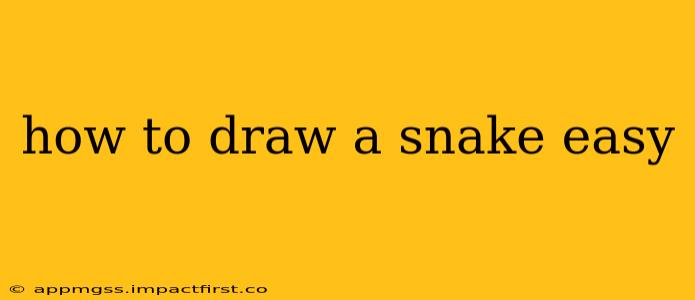Drawing a snake might seem intimidating, but with a few simple steps, even beginners can create a realistic-looking serpent. This guide provides an easy method, perfect for kids and adults alike, focusing on basic shapes and smooth lines. Let's slither into the world of snake drawing!
What Materials Will I Need?
Before we begin, gather your art supplies. You'll need:
- Paper: Any type of paper will do, but thicker paper is preferable to prevent smudging.
- Pencil: A regular HB pencil works best for sketching.
- Eraser: To correct any mistakes.
- Colored Pencils, Markers, or Crayons (optional): To add color and detail to your finished snake drawing.
Step-by-Step Instructions: Drawing a Simple Snake
-
Start with a Simple Curve: Begin by drawing a slightly curved line. This will form the backbone of your snake. Don't worry about making it perfect; a natural, slightly wobbly line is fine. Think of a gentle 'S' shape.
-
Add the Belly: Underneath the curved line, draw a slightly shorter, parallel curve. This represents the snake's belly. Leave a little space between the two lines.
-
Connect the Curves: Gently connect the ends of the top and bottom curves to create the snake's head and tail. The head should be slightly wider than the tail.
-
Shape the Head: Refine the head by drawing a slightly pointed oval shape at the front of the upper curve. Add two small circles for eyes. You can add a simple forked tongue extending from the bottom of the head for added detail.
-
Add the Tail: Similarly, refine the tail by slightly tapering the bottom curve to a point.
-
Refine the Body: To give your snake more dimension and realism, you can add some slight curves and bumps along the body. Don’t make these too extreme; subtle variations create a more natural look. Imagine the snake’s muscles subtly flexing as it moves.
-
Erase Unnecessary Lines: Carefully erase any extra lines you might have drawn to clean up your sketch.
-
Add Details (Optional): Once you're happy with the basic shape, you can add more detail. You could add scales by drawing small, overlapping ovals along the snake’s body. You can also experiment with adding patterns or textures to your snake's skin.
How to Draw Different Types of Snakes?
While the above method creates a generic snake, you can adapt it to draw different types:
-
Cobra: For a cobra, make the head broader and more hood-like. Add a distinctive hood shape behind the head.
-
Python: Pythons are typically thicker and have shorter tails. Focus on creating a more robust body.
-
Viper: Vipers have triangular heads and can be depicted with more angular lines.
The key is to observe real snake images and adapt your basic snake drawing to reflect their unique characteristics.
What are some easy tips for drawing a snake?
Use Light Pencil Strokes: Start with light pencil strokes so you can easily erase and make adjustments. Gradually darken the lines as you refine your drawing.
Practice Makes Perfect: Don't be discouraged if your first attempt isn't perfect. Keep practicing, experimenting with different shapes and lines. The more you draw, the better you’ll become.
Observe Real Snakes: Looking at real images or videos of snakes can help you understand their anatomy and movement, which will improve your drawing accuracy.
How do I make my snake drawing more realistic?
Adding details like scales, shading, and a more complex background can make your snake drawing more realistic. Experiment with different shading techniques to give your snake dimension and depth.
This guide provides a simple and enjoyable way to draw a snake. Remember, the most important thing is to have fun and let your creativity flow! So grab your pencils and start creating your own slithering masterpiece!
